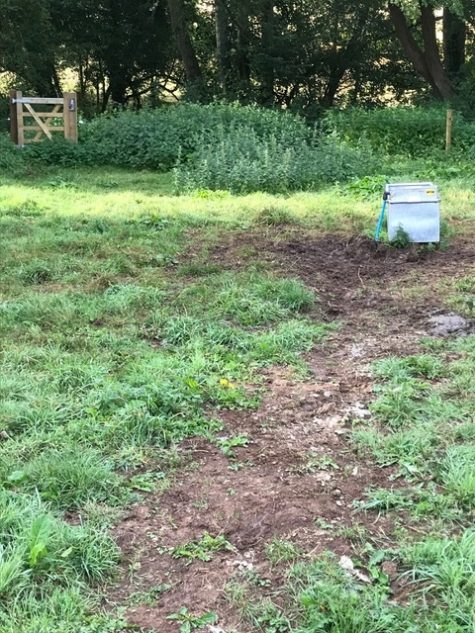BART have been working hard to address water quality issues and improve habitat for wildlife on the Cam Brook, Midford. The Caring for the Cam project is being funded by players of People’s Postcode Lottery enabling BART to deliver exciting river restoration works alongside monitoring, training and community events to make the Cam better for the wildlife that depend on it and the people who enjoy it.
The project is addressing the issues identified on the Cam Brook which includes a stretch that has become canalised by weirs downstream, resulting in sluggish flows and limited habitat diversity. Bank poaching by livestock entering the water to drink has led to the collapse of parts of the bank and the entry of sediment into the river which, when combined with the input of nutrients from urine and faeces, has resulted in poor water quality, impacting fish habitat. Bankside habitat has suffered from the impact of livestock poaching and therefore in places there is a lack of riparian vegetation necessary to support wildlife including birds and the endangered water vole.

Our Cam-Do Attitude
We are proud to announce that we have now completed the next phase of our project on the Cam Brook to reduce the impacts of poaching by livestock along the banks of the river. Working with contractors and building a working relationship with the respective landowner, BART have installed approximately 700 metres of permanent solar powered electric fencing, which will prevent livestock from entering the water and allow the riparian buffer strip to establish. Gates have been installed to allow access to the brook for anglers and bankside management. Instead of livestock drinking from the brook, the animals now have access to a new drinking trough situated away from the watercourse. These measures will improve the conditions of the brook by preventing livestock from entering the watercourse, destabilising bank faces and defecating in the brook. The fencing will allow buffer strips to establish, reducing run-off and the input of fine sediment caused by pastoral farming. A very simple solution with widespread benefits!
Still To Come
BART have led a series of riverfly monitor training events to enable local people to care for the river. With a number of new monitors in the area there are now more opportunities for issues to be spotted at an early stage and action to be taken. The next phase of the project will be to plant up the riparian buffer strip with native vegetation which will protect the integrity of the banks, filter harmful pollutants and provide cover for wildlife. If you are local to the project area and wish to get involved in the community tree planting, please contact george@bristolavonriverstrust.org. BART will be hosting community engagement and education events to showcase our work and encourage community ownership of the brook to conserve and improve its condition into the future.
Building On Success
The latest work builds on downstream river restoration works funded by the Environment Agency’s WEIF fund to improve the flow of the brook where it has become canalised and protect the banks from livestock poaching. With the help of a very willing landowner (and his tractor) we removed a timber and rock weir and re-profiled three boulder weirs to reduce the impounding effect of the structures, allowing the river to flow more naturally to benefit wild fish. We installed flow deflectors and brushwood mattresses at various locations in the channel to improve the sinuosity along the artificially straight section of the Cam Brook and provide refuge for fish and invertebrates. These works have already re-created riffle-pool habitat; reducing the amount of silt on the river bed, cleaning gravels and creating potential spawning habitat for wild fish. Our operations team delivered a programme of coppicing of bankside vegetation where the brook was over shaded, allowing light to penetrate the stream with a dappling effect to encourage macrophyte growth which we would expect to see throughout the reach, improving the available freshwater habitat. 460 metres of fencing has closed off the river from livestock and one formalised drinking bay in the brook has significantly reduced the quantity of sediment and nutrient input throughout this stretch.
BART’s latest riverfly monitoring training found all 8 key species of riverfly in the re-instated riffle-pool habitat which is fantastic news for the health of the brook! We will be showcasing our results soon so keep your eyes peeled.

Postcode Local Trust is a grant-giving charity funded entirely by players of People’s Postcode Lottery. Our project received funding from the Trust to complete the river restoration works and engage with the community.








